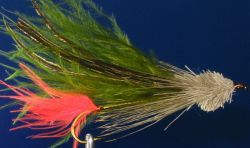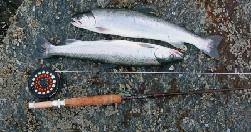
Springtime Dollies by Ken McBroom
article copyright
Spring is fast approaching the great lands of Alaska and spring is synonymous with fishing in Alaska. Many cold dark months have been spent dreaming about the end of winter, the break-up of ice, and the emerging fry from the many streams across Alaska. Emerging fry in Alaska means feeding frenzies that can test the nerves of the most seasoned angler. These frenzies occur in many different types of watersheds but for this article we will focus on estuaries where a river or creek meets the sea and where Dolly Varden come to feed.
Estuaries throughout Alaska become fish magnets as the snowmelt fills the rivers. Often times rivers and creeks are tough to fish this time of year because of this increase in water flow. Inquisitive anglers, who tend to rush the season a bit, found long ago the opportunities provided by this natural occurrence so vital to the life cycle of so many fish, birds and other animals residing close to these rivers and creeks but don’t expect open conversations about these early spring haunts as they seem to be some of the last remaining secrets among anglers. I do not intend on giving away any spots in this article but I assure you there are more than enough to go around in Alaska and some that get little or no pressure from other anglers.
To understand the reasons for the great fishing at these estuaries one must first learn why. Throughout the summer, salmon move up stream to lay eggs. These eggs provide the Dollies with much needed protein to survive the long winter months but that is for another article. These eggs hatch into what is called an alevin, which is a small salmon with its egg sac still attached. The content of the egg sac is consumed as they begin to grow into fry. Most of the fry and alevins remain in the fresh water for a few seasons with the exception of the Chum salmon which journey to at least the brackish water provided by the estuary where they will reside until mature enough to journey to the open ocean.
The Snow high in the Southeast Alaska mountains begin to melt in March through early May, depending on the season. The run-off from this snowmelt creates higher flow rates within these watersheds causing even more difficulties for the immature salmon trying to survive. This cycle begins the angling season in Alaska and anglers should be there to take advantage of this great opportunity. The action seen at these estuaries are second to none and occur well in advance of the on-slaught of tourist that flock to Alaska each summer.
 Dolly Varden are aggressive and willing to attack anything resembling a young salmon. Anything from streamers at the end of a fly line to spoons on a spinning outfit will work great for these tenacious creatures, which are a member of the char family. My weapon of choice has got to be the fly rod. With a fly the angler can vary the presentation on every cast. Variations of the presentations will help the angler entice many more strikes than with a spoon or spinner. Let us look at the reasons why.
Dolly Varden are aggressive and willing to attack anything resembling a young salmon. Anything from streamers at the end of a fly line to spoons on a spinning outfit will work great for these tenacious creatures, which are a member of the char family. My weapon of choice has got to be the fly rod. With a fly the angler can vary the presentation on every cast. Variations of the presentations will help the angler entice many more strikes than with a spoon or spinner. Let us look at the reasons why.
With a spoon or spinner your presentation is pretty much cast and retrieve. The weight of the spoon or spinner limits your ability to vary your presentation throughout the retrieve. In order to keep your presentation up in the water column, where the Dollies are and the bottom feeders aren’t, you must perform a fast retrieve throughout the presentation. Rests assure you can and will catch many Dollies in this manner but the fly allows for various presentations even within the same cast. Here are some of the presentations allowed by the fly.
Fast strip: The fast strip retrieve is a good presentation to start with in your selected estuary or stream. A fast retrieve is performed by completing the cast and immediately beginning the retrieve with a long strip with the only hesitation being the brief moment it takes to move your stripping hand up the line. This retrieve will present the fly on or just below the surface of the water and can entice some tremendous strikes so be ready and check your nerves at the truck. The reason this technique is a good one to begin with is that it entices the more aggressive fish first. These may be the only fish of the many below that will attack a fast-stripped fly on or near the surface. This is important and can allow you more productive fishing time in one spot. If you were to use one of the following presentations what you would see is the aggressive fish taking the fly but running off the less aggressive fish in the process and possibly running those fish to another area, which could be out of your range even with spinning gear. So keep the less aggressive fish nearby by targeting the aggressive fish on the surface where there is little or no competition from below.
Pause strip: The pause strip is a great retrieve and has really brought many Dollies to hand. The pause strip retrieve can be performed in many fashions. One may make two fast strips immediately then pause or one might wait a few seconds to allow the fly to sink to a certain depth before beginning the pause strip. Whether fast strip then pause or slow strip three pulls then pause, it is all up to the angler to try different variations in order to get a strike.
Slow strip: The slow strip is the best finish up retrieve for a certain spot. In the off chance that the bite slows while using the other strips and variation of those strips the slow strip just may entice a few more strikes and often times they can be the largest fish in the area as the same holds true for many of Alaska’s sport fish as the larger fish will refuse, with good reason, to expend too much energy chasing a meal that may not even replenish them with the energy burned to catch them. Therefore, as your nerves begin to settle back to normal and two or three fat Dollies are in the creel for supper it is time to relax and meticulously cover the area with the slow strip retrieve. The name is self-explanatory but there are several variations of the retrieve worth noting. The slow strip retrieve may begin with two lightning fast strips followed by a countdown then the slow strip that may include a pause or two on the way in. The important thing is to remember that the majority of the retrieve should be slow. This allows the fish to decide if it wants to expend the energy needed to take your presentation, that decision is based on how the fly is moving through the water. There are many more strips out there to try but these three and the many variations within can be more than enough to provide many hours of fish fighting fun.
 One question that is brought up in angling circles is which fly line to use. Well I have to say I personally have refused to allow the many hundreds of fly line types to interfere with my sanity and so I have one spool of floating and one spool of sinking. Add a weighted fly or a split shot to either the floating or the sinking line and you have several different presentations at your disposal. Now having said that there are times when a special situation presents itself and you may be forced to purchase a special line for that particular circumstance. Often times, in those situations, you may be introduced to a line you did not even know existed and unless you are going to fish that same locale later on you may never find a reason to purchase that line again but you know its out there.
One question that is brought up in angling circles is which fly line to use. Well I have to say I personally have refused to allow the many hundreds of fly line types to interfere with my sanity and so I have one spool of floating and one spool of sinking. Add a weighted fly or a split shot to either the floating or the sinking line and you have several different presentations at your disposal. Now having said that there are times when a special situation presents itself and you may be forced to purchase a special line for that particular circumstance. Often times, in those situations, you may be introduced to a line you did not even know existed and unless you are going to fish that same locale later on you may never find a reason to purchase that line again but you know its out there.
Flies for Dollies can really vary throughout the season but during early spring only a few stands out. Remember, during early spring Dollies are feeding on fry and alevins. Streamers are the most effective during this time as the fish are somewhat aggressive and hungry and tend to focus on the most abundant forage at the time, which are these young salmon. One important factor to consider is color. Dollies have been known to prefer a certain color not just from day to day but even hour to hour. So fill the fly box with several streamers of different colors and take advantage of this early season and crowd less, angling opportunity.
author website: visit | author bio
![]()

